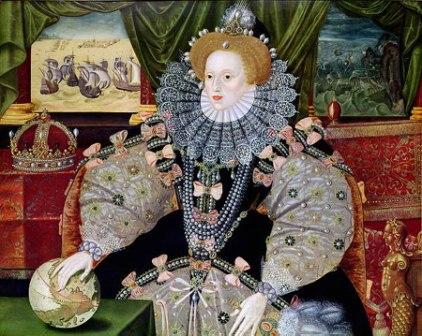 |
| The tomb of Katherine Parr in St. Mary's Chapel, Sudeley Castle. Photo shared for public use by Lara E. Eakins of TudorHistory.org. |
On this day in Tudor history, 1548, the Dowager Queen Katherine Parr died from “childbed fever”, or puerperal sepsis, at her home of Sudeley Castle. With her final breaths, Katherine Parr voiced her disappointment in her husband, Thomas Seymour, for all the pain he had caused her. Thomas had been inappropriate with his wife's stepdaughter, Elizabeth Tudor (Plowden, 100-101).
Henry VIII's sixth and final wife was laid to rest on the grounds of Sudeley Castle in St. Mary's Chapel.
 |
| An exterior view of Sudeley Castle. Picture acquired through Wikimedia Commons. Image public domain. |
After being widowed just one year before, upon the death of her third husband, King Henry VIII, Katherine had seized her chance at happiness by marrying Thomas Seymour. Thomas had been pursuing Katherine before she had caught King Henry's eye (Porter, 284-291). Thomas Seymour was also the uncle of Katherine's stepson, the boy-king Edward VI.
 |
| The Jersey Portrait. The sitter was formally thought to be Jane Grey, but has now been identified as Katherine Parr. Picture acquired through Flickr courtesy of Inor19. |
 Katherine and Thomas's courtship appears to have been a passionate one, but their marriage suffered when Thomas became fixated on Katherine's young stepdaughter, Elizabeth Tudor (Porter, 307-315). Elizabeth was in their care, living under their roof. Thomas abused his ward by behaving inappropriately with her.
Katherine and Thomas's courtship appears to have been a passionate one, but their marriage suffered when Thomas became fixated on Katherine's young stepdaughter, Elizabeth Tudor (Porter, 307-315). Elizabeth was in their care, living under their roof. Thomas abused his ward by behaving inappropriately with her. Katherine Parr, although a highly educated and perceptive woman, was conflicted as to how to handle the situation. Torn between her husband and the stepchild she regarded as her own daughter, Katherine began participating in her husband's escapades. Who knows how she rationalized her involvement to herself; perhaps she believed it would bring her closer to her husband, or perhaps she thought it would help her to keep an eye on the behavior.
When Katherine became pregnant, she became far less tolerant of her husband interest in Elizabeth, and she had the Princess sent away (Porter, 313-314). Still, Elizabeth and Katherine were not on bad terms, and they wrote to one another during their separation (Porter, 315-316). Upon learning of her stepmother's death, Elizabeth was devastated. Despite the betrayal she had experienced in Katherine Parr's care, she would never forget that this was the woman who had treated her like she was her own child. She had loved her, interceded for her with her father, and given her with the best of educations (Plowden, 75, 93). Just a few years before (1545), the Princess Elizabeth had given her stepmother her own translation of The Mirror of the Sinful Soul, by Margaret of Navarre. This present was intended to show off her academic skills, which she had acquired thanks to the tutors provided to her by her stepmother. The cover was embroidered in her own hand, and included Katherine Parr's initials, "KP" in the center.
Katherine herself was quite the role model for the young Elizabeth in matters of education, government,and religion. Katherine was an author, and she earned the distinction of becoming the first English Queen to have a work of literature published under her own name. Just one year after her wedding to Henry VIII, the mature and accomplished Katherine was entrusted to be regent of England for three months. Finally, Katherine was a champion for church reform, even though it nearly cost her her life (Porter, 225-267).
 |
| Prayers and Meditations, a book authored by Queen Katherine Parr. This copy was perhaps written in her own hand. Picture acquired through Wikimedia Commons. Image public domain. |
Sadly, the fate of Queen Katherine Parr's only biological child, Mary Seymour, is unknown. While she lived for a time in the care of Katherine Parr's friend, Katherine Willoughby, she disappears from the records and probably did not live into adulthood.
 |
| A portrait of Queen Katherine Parr, circa 1545. Picture acquired through Flickr courtesy of Inor19. Image public domain. |
In Other Katherine Parr News...
This Sunday, September 9th, marks the grande finale of the year-long celebrations at Sudeley Castle for the Katherine Parr Quincentenary. The Quincentenary marks the 500th anniversary of the birth of Katherine Parr, the 6th and final wife of King Henry VIII. |
| An exterior view of a knot garden at Sudeley Castle. Picture acquired through Wikimedia Commons. Image public domain. |
Sudeley Castle has undertaken a remarkable historical challenge: re-creating the funeral of England's Queen Dowager from 1548. The event, which is sold out, asks guests to participate, rather than mereley spectate, by having them portray actual funeral guests.This re-enactment, led by eminent Tudor historian Dr. David Starkey, truly is "living history" at its finest!
 |
| A close-up of the tomb of Queen Katherine Parr in St.Mary's Chapel, Sudeley Castle. Photo shared for public use by Lara E. Eakins of TudorHistory.org. |
Sources
Porter, Linda. Katherine the Queen. New York: St. Martin's Press, 2010. Print.
Plowden, Alison. The Young Elizabeth. Gloucestershire: The History Press, 2011. Print.


